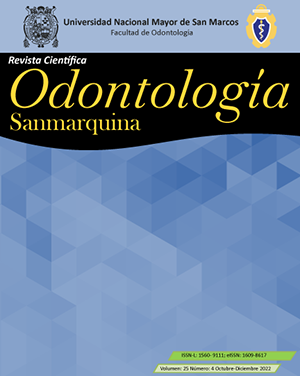Accuracy of Demirjian, Willems I and II dental age estimation methods in a Cusquenian population
DOI:
https://doi.org/10.15381/os.v25i4.22222Keywords:
Forensic dentistry, Age determination by teeth, Tooth germ, Dental research, Panoramic radiographyAbstract
Objective. To determine the accuracy of the dental age estimation methods proposed by Demirjian, Willems I and its modification Willems II with the chronological age in digital panoramic radiographs of patients between 6 and 16 years of age attended at the CERADENT Cusco - Peru radiological center, from January to June 2021. Methods. It was a descriptive, cross-sectional and retrospective study in which 220 digital panoramic radiographs of patients of both sexes (6-16 years) were evaluated. The stages of dental maturation proposed by Demirjian et al. were recorded in each dental piece of the lower left hemiarch to subsequently determine the dental age by means of the Willems I, II and Demirjian methods Results. The Willcoxon test was applied to determine the difference in means between the chronological age and the estimated dental age according to each method. For the total sample, it was found that the Demirjian method was the most accurate, presenting a slight underestimation of age in some age ranges for both sexes, followed by the Willems II method and finally the least accurate was the Willems I method, there were minimal differences between these methods, there were also similarities between the results obtained through the Willems I and II methods. Conclusions. The Demirjian method was the most accurate method for estimating dental age in a Cusquenian population; however, since there were no wide differences between the methods studied, the three methods were good age estimators.
Downloads
Downloads
Published
Issue
Section
License
Copyright (c) 2022 Elflori Ricardo Rios Florez, Mirna Mayra Palomino Soto

This work is licensed under a Creative Commons Attribution 4.0 International License.
AUTHORS RETAIN THEIR RIGHTS:
a. Authors retain their trade mark rights and patent, and also on any process or procedure described in the article.
b. Authors retain their right to share, copy, distribute, perform and publicly communicate their article (eg, to place their article in an institutional repository or publish it in a book), with an acknowledgment of its initial publication in the Odontología Sanmarquina.
c. Authors retain theirs right to make a subsequent publication of their work, to use the article or any part thereof (eg a compilation of his papers, lecture notes, thesis, or a book), always indicating the source of publication (the originator of the work, journal, volume, number and date).






